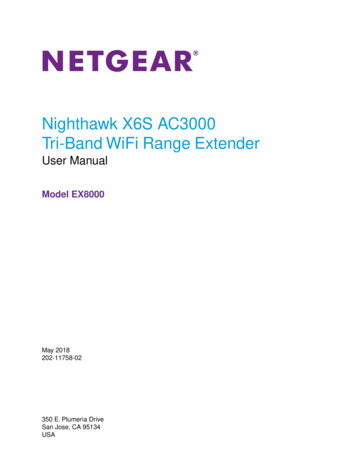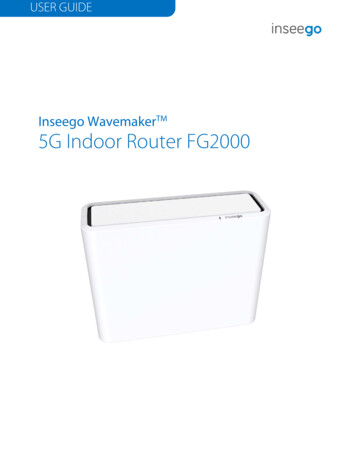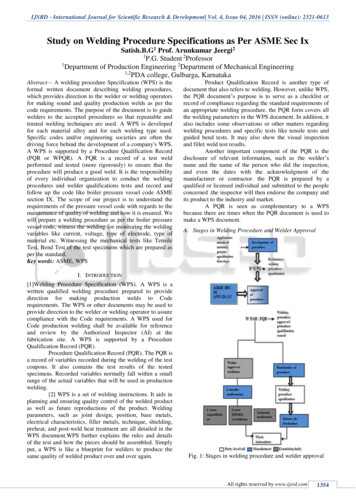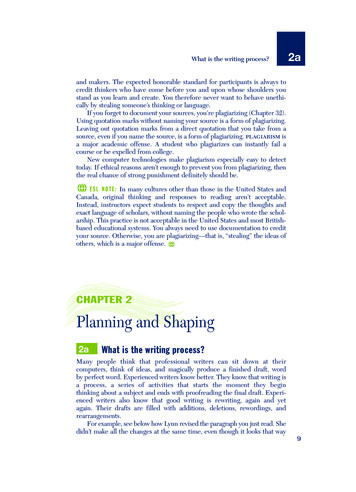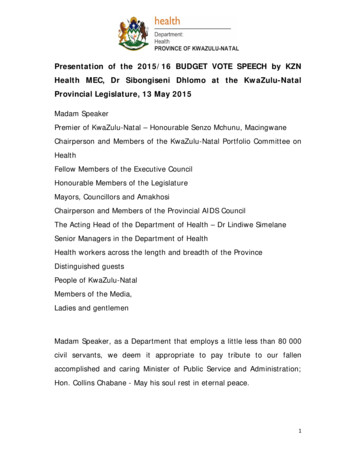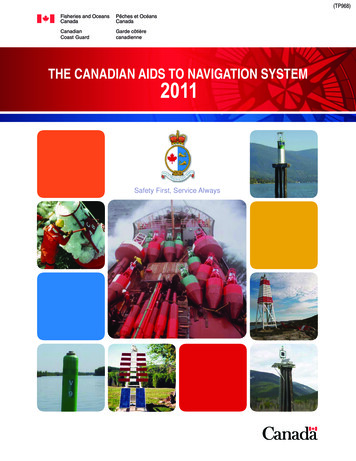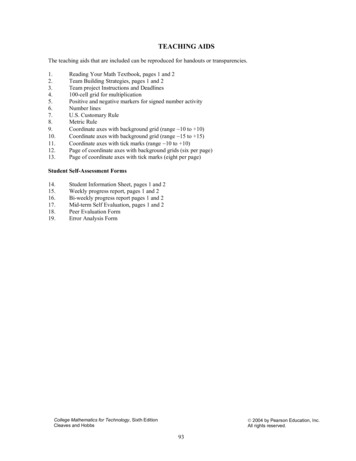
Transcription
TEACHING AIDSThe teaching aids that are included can be reproduced for handouts or ng Your Math Textbook, pages 1 and 2Team Building Strategies, pages 1 and 2Team project Instructions and Deadlines100-cell grid for multiplicationPositive and negative markers for signed number activityNumber linesU.S. Customary RuleMetric RuleCoordinate axes with background grid (range 10 to 10)Coordinate axes with background grid (range 15 to 15)Coordinate axes with tick marks (range 10 to 10)Page of coordinate axes with background grids (six per page)Page of coordinate axes with tick marks (eight per page)Student Self-Assessment Forms14.15.16.17.18.19.Student Information Sheet, pages 1 and 2Weekly progress report, pages 1 and 2Bi-weekly progress report pages 1 and 2Mid-term Self Evaluation, pages 1 and 2Peer Evaluation FormError Analysis Form 2004 by Pearson Education, Inc.All rights reserved.College Mathematics for Technology, Sixth EditionCleaves and Hobbs93
READING YOUR MATH TEXTBOOKBeginning a Chapter: First, examine the chapter opening page or pages. Read the Chapter Title, Section Titles, and Learning Outcomes todetermine what will be covered in this chapter. Read the Chapter Summary that is near the end of the chapter. The Chapter Summary lists each learning outcome ofthe chapter with some tips on what to remember and at least one example. Use the summary as a checklist to rateyour initial knowledge of the chapter’s learning outcomes. You can use a numerical rating for this. For example, (0) means you know nothing about this topic, (1) meansyou know a little but not much about this topic, (2) means you know quite a bit but there may be a few gaps, and(3) means you know this topic very well. Another possible rating strategy can be a check, minus, and plus system. ( ) means you know the topicmoderately well, ( – ) means you need to work on this topic, and ( ) means you know the topic very well.Beginning a Section: Read the Section Title and the Learning Outcomes for the section. Read the Introductory Paragraph. Locate the Self-Study Exercises at the end of the section. Read the directions for each set of exercises. This willgive you an idea of the type of problems you will be solving and what to look for as you read the section. Begin reading the section. Make notes on concepts that you do not understand or examples for which you are notable to follow the explanation. Your notes will be the basis for questions to ask in class.Continuing Through the Chapter: Work on one learning outcome at a time. After reading and studying one learning outcome, try some of theexercises for that outcome. The Self-Study Exercises are coded by outcomes and all the answers are in the text.Always check your answers with the text. Assess your understanding of each outcome and practice or get help asyou think necessary. For additional practice use the Study Wizard or the website material. Be realistic with yourself-assessment! Work the assignments or activities required by your instructor. The answers to the odd-numbered AssignmentExercises are in your text and the solution are in the Student Solutions Manual. Continue outcome by outcome, section by section, checking your understanding as you go. 2004 by Pearson Education, Inc.All rights reserved.College Mathematics for Technology, Sixth EditionCleaves and HobbsTeaching Aid 1, p. 194
Reviewing the Chapter: After finishing a chapter, thumb though the entire chapter reading the procedure boxes, the Tip! boxes and learningstrategies. Read the Chapter Summary once more, and again rate your understanding of each outcome. Review or getassistance as necessary. Work the Chapter Trial Test at the end of the chapter and check your answers. The odd-numbered answers are inyour text and the solutions are in the Student Solutions Manual. Review or get assistance as necessary.Finishing the Chapter: Prepare for the test on the chapter. Ask your instructor which outcomes require mastery for testing purposes. Someoutcomes may not require mastery and others may even be optional. Find our as much about the format and lengthof the test as you can. Know your instructor’s expectations (is showing all steps required, are calculators allowed, isthere a time limit on the test, etc.).General Tips: Prepare for every class meeting by previewing the material that is to be covered in class.Prepare questions that you will ask if they are not answered in the instructor’s presentation or in the classdiscussion. Instructors will have more patience with students who have prepared for class. Practice an outcome until you feel confident that you understand the concept. There is an abundance of practiceavailable to you that is specifically geared to your text (Self-Study Exercises, Assignment Exercises, Study Wizard,and even a Premium or Companion Website ). Other practice is available through generic mathematics software andother texts. Only you know when you have practiced enough, but be realistic with your self-assessment of yourunderstanding. Practice helps you retain the information for a longer period of time, but don’t wear yourself out!Finding that appropriate balance is your goal. The Concepts Analysis exercises that follow the Assignment Exercises help you to check your conceptualunderstanding. Don’t forget the Glossary and Index! As you move through the text you may forget definitions and concepts. Maybeyou are not starting your study at the beginning of the text and need to review a few concepts that were in thechapters not covered. Examining the Glossary and Index should be your first step in accomplishing your review. Your ultimate goal should be to develop independent learning skills and to become as self-sufficient as possible inyour study of mathematics.Good luck on your study of mathematics!Cheryl CleavesMargie HobbsCollege Mathematics for Technology, Sixth EditionCleaves and HobbsTeaching Aid 1, p. 2 2004 by Pearson Education, Inc.All rights reserved.
TEAM BUILDING STRATEGIES“Play ball!” signals the start of a baseball game. But it also signals the start of a team effort to achieve a goal– winning the game. No one player can achieve this goal alone. All the players together cannot achieve this goal ifeach works alone. But when players work as a team, each carrying out his or her function in a coordinated effort, thenthe goal can be attained.This is why more and more businesses, industries, and colleges use teams to achieve goals. The world todayis so complex, with so many variables, so many aspects to consider, that it is difficult for one person to perform everytask needed to arrive at the best possible solution. Several people functioning as a team can divide the tasks amongthemselves and, as a group, share and discuss their findings. Together they will reach a far better solution than anysingle individual can.Team Process You may be asked in class to achieve certain goals or to participate in a team project. Five majorcomponents make a team successful. The team must first define the tasks it has agreed to perform. The task definitions should be accepted byand clearly communicated to all team members. The team leader is responsible for distributing tasks among team members, keeping in mind eachmember’s particular expertise. Each team member performs the individual tasks to which he or she has committed and prepares a writtenor oral report of the work completed. The team compiles the results of each member’s work and uses the results to ma e decisions. The team prepares a comprehensive report of its work.Team DynamicsProcedural needs and the role of' the team leader(s) or facilitator(s). The team may involve three or more members,maybe even six to eight, and may or may not have a designated leader. If there is no leader, either elected orappointed, then team members who have strengths in the areas of need will likely surface to offer leadership assituations arise. The team leader has several “housekeeping” chores. These include selecting a time to meet andsecuring a place to meet. The team leader should ensure the meeting place has enough space, and is comfortable andaccessible for all team members. The team leader should call team meetings by sending advance communicationregarding the time, location, and purpose of the meetings. A team member should be selected to take meeting minutes,taking care to record individual assignments and deadlines.Team responsibilities. Typical responsibilities of teams include setting goals and priorities, identifying thetasks to be performed, delegating the tasks among team members, motivating members who get behind, supportingmembers who lack confidence, helping members work out convicts, keeping everyone on target, and so on. Teamswork best when tasks and responsibilities are matched to the talents of the individual members. For example, libraryresearch is best delegated to team members who are independent workers, and interviews are best delegated to teammembers who have strong interpersonal skills. The effectiveness of the team depends on effectively utilizing thetalents of all its members and each member’s recognition of their worth to the team.Commit to Team GoalsFor a team to be successful, each member must be committed to the success of the team and to its goals. Each membermust help the team move forward, first by completing his or her share of the work, and then by motivating othermembers to do the same.College Mathematics for Technology, Sixth EditionCleaves and HobbsTeaching Aid 2, p. 1 2004 by Pearson Education, Inc.All rights reserved.
Use a Meeting AgendaAs a team member or leader, you may find it helpful to use a Meeting Agenda to ensure that all necessary matters arecovered at your meetings. Here are some suggestions to consider in preparing an agenda.Team Goals (listed)Call to Order (get attention)Introduction to Today’s Meeting (purpose, etc.)Review of Agenda (add items, remove items, rank items)Reports on Individual Assignments (list reports due)Other Reports, Activities, or Discussions (list them)Project Status Review (what progress so far?)Follow-up Assignments (what, who, when)Upcoming Events (special meetings, presentations, etc.)Review of Action Items or Tasks Completed (what’s done)Review of Action Items or Tasks to Be Completed (what’s needed)Next Meeting’s Agenda Items [with specific assignments so that everyone’s ready)Special Activity for Today (if any)Questions and Answers (helps evaluate meeting)Adjournment (end meeting)Initial Team MeetingAt an initial meeting, the team must clarify the nature of the problem to be solved or the task to beperformed so that everyone understands the situation the same way. This is a good time to set priorities sothat everyone knows what kinds of solutions are acceptable. If some priorities are more important thanothers, the team should distinguish between the “must have” priorities and the “nice to have” priorities.The team must then set deadlines for completing various parts of the team project. All team membersshould agree with and support these deadlines.Individual or Pair ResponsibilitiesOnce the problem is clear and the priorities and deadlines have been set, team members individually, orpossibly in twos, gather the information needed to arrive at a solution. Individuals or pairs then prepare awritten or oral summary of findings and present it to the entire team.Follow-up Team MeetingsThe team will need to meet periodically to report individual findings and share in-formation. When all thefindings are integrated, the team members need to discuss the information and propose solutions to theproblem. As a next step, they evaluate each solution to see if it meets the priorities agreed to previously.Then the members select the best solution. The best one is the one that meets all “must have” priorities andas many “nice to have” priorities as possible.Document and Present Findings and SolutionsThe final task for the team is to present its findings in an organized form; this may be an oral report by anindividual chosen by the team, a group presentation such as a panel discussion, or a written report perhapswith different sections prepared by different members. In some cases, the presentation will consist of both awritten and an oral report. In any case, the presentation of the findings should include a statement of theproblem, the method used to solve the problem, and the solution or recommendation. An effectivepresentation or report is well-organized, clearly communicated, and visually attractive. 2004 by Pearson Education, Inc.All rights reserved.College Mathematics for Technology, Sixth EditionCleaves and HobbsTeaching Aid 2, p. 297
TEAM PROJECTCourseProjectTermTeam Members:Teams will be three to four students. Each student will have a specific responsibility in the project. Peer evaluationswill be part of the total project grade.Written ReportPresentation One report for each teamNarrative portion of report will be three to five typed, double-spacedpages. Narrative portion should include:1.Statement of problem2.Method for solving problem3.Explanation of each team member’s responsibility4.Findings5.Conclusion Ten to fifteen minutesShare the five components of the written report with the class. Do NOTread the written report. Summarize the written report and useappropriate visual aids for the class.Presentation does not have to involve all team members; but, each teammember must be prepared to answer questions about the project. Deadlines Brief description of project, team members,and team assignmentsDraft of written reportFinal copy of written reportOral presentation 2004 by Pearson Education, Inc.All rights reserved.College Mathematics for Technology, Sixth EditionCleaves and HobbsTeaching Aid 398
100-Cell Grid for Multiplication and Fraction Activities01234567890123456789 2004 by Pearson Education, Inc.All rights reserved.College Mathematics for Technology, Sixth EditionCleaves and HobbsTeaching Aid 499
Positive and Negative Markers for Signed Number of Activities 2004 by Pearson Education, Inc.All rights reserved.College Mathematics for Technology, Fifth EditionCleaves and HobbsTeaching Aid 5100
Number 0 2004 by Pearson Education, Inc.All rights reserved.College Mathematics for Technology, Fifth EditionCleaves and HobbsTeaching Aid 6101
U.S. Customary rule 2004 by Pearson Education, Inc.All rights reserved.College Mathematics for Technology, Fifth EditionCleaves and HobbsTeaching Aid 7102
Metric rule 2004 by Pearson Education, Inc.All rights reserved.College Mathematics for Technology, Fifth EditionCleaves and HobbsTeaching Aid 8103
Coordinate axes with background grid (range 10 to 10) 2004 by Pearson Education, Inc.All rights reserved.College Mathematics for Technology, Fifth EditionCleaves and HobbsTeaching Aid 9104
Coordinate axes with background grid (range 15 to 15) 2004 by Pearson Education, Inc.All rights reserved.College Mathematics for Technology, Fifth EditionCleaves and HobbsTeaching Aid 10105
Coordinate axes with tick marks (range 10 to 10)105105510510 2004 by Pearson Education, Inc.All rights reserved.College Mathematics for Technology, Fifth EditionCleaves and HobbsTeaching Aid 11106
Page of Coordinate Axes with background grids (six per page)yyxyxyxyxyxx 2004 by Pearson Education, Inc.All rights reserved.College Mathematics for Technology, Fifth EditionCleaves and HobbsTeaching Aid 12107
Page of coordinate axes with tick marks (eight per page) 2004 by Pearson Education, Inc.All rights reserved.College Mathematics for Technology, Fifth EditionCleaves and HobbsTeaching Aid 13108
Student Information lPhoneSchedule of Classes:CourseDaysTimesWork daySundayOther Major Commitments of Time: 2004 by Pearson Education, Inc.All rights reserved.College Mathematics for Technology, Fifth EditionCleaves and HobbsTeaching Aid 14109
Student Information Sheet, page 2Commitment for Studying Math Outside of Class:Preferences For Studying (check all that apply):Studying aloneStudying in learning centerGetting help from a tutorGetting help from another instructorStudying with a classmateStudying with a group of classmatesGetting help from my instructorGetting help from a friend or family SundayPersonal Mathematics History:High School CoursesFinal GradeTimes EnrolledCourse Grade GoalA B CCollege Math CoursesFinal GradeTimes EnrolledWhat do you personally want to learn in this course?Attitude about Mathematics: 2004 by Pearson Education, Inc.All rights reserved.College Mathematics for Technology, Sixth EditionCleaves and HobbsTeaching Aid 14, p. 2110
Weekly Progress ReportNameReport NumberSectionDateThis report is a self-assessment of the progress made in the previous week.Attendance (List dates of absences):Assignments (List assignments not completed):Out-of-Class Time Spent on Mathematics Assignments:Make calculations to complete the statements.(Plot the time spent for each day and connect thepoints forming a line graph.I spent a total of approximately minutes orhours studying or working out-of-class assignments inmathematics.240 min210 min180 min150 min120 min90 min60 min30 minI spent an average of minutes or hours perday studying or working out-of-class assignments inmathematics.I spent approximately hours alone studying orworking assignments in mathematics.M Tu W Th FI spent approximately hours studying or workingassignments in mathematics in a resource center or withan instructor or tutor.Sa SuI spent approximately hours studying or workingassignments in mathematics in a study group.Members in my study group are:I understand the topics covered during this report period (Check one):very wellsomewhatvery little 2004 by Prentice-Hall, Inc.Pearson EducationAll rights reserved.College Mathematics for Technology, Sixth EditionCleaves and HobbsTeaching Aid 15, p. 1111
Weekly Progress Report, page 2Comments:Instructor’s Comments:My term grade to date is approximately:Random Assignment Check:(Your instructor will give a random list of problems from your assignments to be transferred to this sheet.Show all steps of your solutions.) 2004 by Pearson Education, Inc.All rights reserved.College Mathematics for Technology, Sixth EditionCleaves and HobbsTeaching Aid 15, p. 2112
Bi-Weekly Progress ReportNameReport NumberSectionDateThis report is a self-assessment of the progress made in the previous two-week period.Attendance (List dates of absences.):Assignments (List assignments not completed.):Out-of-Class Time Spent on Mathematics Assignments:(Plot the time spent for each day and connect the points forming a line graph.240 min210 min180 min150 min120 min90 min60 min30 minM Tu W Th FSa Su M Tu W Th FSa SuMake calculations and complete the statements:I spent a total of approximately minutes or hours studying or working out-of-class assignments inmathematics.I spent an average of minutes or hours per day studying or working out-of-class assignments inmathematics.I spent approximately hours alone studying or working assignments in mathematics.I spent approximately hours studying or working assignments in mathematics in a resource center or with aninstructor or tutor.I spent approximately hours studying or working assignments in mathematics in a study group.Members in my study group are:I understand the topics covered during this report period (check one):very wellsomewhatvery little 2004 by Pearson Education, Inc.All rights reserved.College Mathematics for Technology, Sixth EditionCleaves and HobbsTeaching Aid 16, p. 1113
Bi-Weekly Progress Report, page 2Comments:Instructor’s Comments:My term grade to date is approximately:Random Assignment Check:(Your instructor will give a random list of problems from your assignments to be transferred to this sheet.Show all steps of your solutions.) 2004 by Pearson Education, Inc.All rights reserved.College Mathematics for Technology, Sixth EditionCleaves and HobbsTeaching Aid 16, p. 2114
Mid-Term Self EvaluationNameSectionDateTest Scores (List.):Test Average:Attendance (List dates of absences.):Assignments (List assignments not completed.):Why have the assignments not been completed?Mid-Term Grade (Calculate according to directions from your instructor.):Desired End-of-Term Grade:What have you been doing outside of class to master the topics of the course?What out-of-class resources have you taken advantage of?Study GroupResource CenterTutorOther (specify)Help from InstructorWhat has been the least effective study technique you have used? 2004 by Pearson Education, Inc.All rights reserved.College Mathematics for Technology, Sixth EditionCleaves and HobbsTeaching Aid 17, p. 1115
Mid-Term Self Evaluation, page 2What has been the most effective study technique you have used?Evaluate the effectiveness of your total study plan.Are you on target for your desired end-of-term grade?Will you make changes in your study habits for the remainder of the term? If so, explain the changes you will make.What can you do differently during class time to improve your progress in the course?What could your instructor do differently during class time to improve your progress in the course?Comments from Instructor: 2004 by Pearson Education, Inc.All rights reserved.College Mathematics for Technology, Sixth EditionCleaves and HobbsTeaching Aid 17, p. 2116
117ProjectLevel of ParticipationScoreCollege Mathematics for Technology, Sixth Editionby Cleaves and HobbsTeaching Aid 18Self EvaluationNameQuality of WorkScoreDate 2004 by Pearson Education, Inc.All rights reserved.CommentsCourse/SectionEvaluate the level of participation and the quality of work for yourself and each member of your group.Assign scaled scores using the scale from 1 to 5 with 5 being the highest score.NameGroup Project Peer Evaluation
NameError Analysis FormConceptual ErrorTest or AssignmentCorrected SolutionSectionError AnalysisCalculation ErrorDateTranscription Error 2004 by Pearson Education, Inc.All rights reserved.Enter incorrect solution exactly as it appears on test or assignment. Check or highlight mistake or mistakes.Show correct solution.If error is due to misunderstanding of a concept, name the concept in question.If in your judgment you understood the concepts involved but you made a miscalculation, name the type of calculation error.If error resulted from the miscopying of the problem or miscopying a portion of the problem from one step to another, identify thetranscription error.Incorrect SolutionUse additional sheets if necessary.ItemNumberIncorrect Solution:Corrected Solution:Conceptual Error:Calculation Error:Transcription Error:College Mathematics for Technology, Sixth EditionCleaves and HobbsTeaching Aid 19118
Reviewing the Chapter: After finishing a chapter, thumb though the entire chapter reading the procedure boxes, the Tip!boxes and learning strategies.

